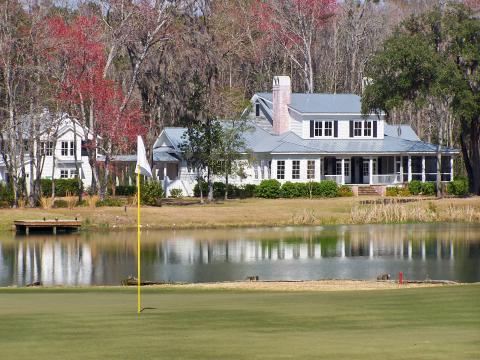 Bear Lake Reserve's nine holes by Nicklaus Design covers the community's mountaintop, with home sites set well back.
Bear Lake Reserve's nine holes by Nicklaus Design covers the community's mountaintop, with home sites set well back.
Before my first trip to Paris many years ago, a friend told me, "There is only one problem with Paris. Too many Frenchmen." It didn't ruin the experience for me; Paris remains among my favorite international cities.
But to borrow a page from my friend's line, the only problem with planned-community golf courses is too many darn houses. Put another way, I have not yet met the golfer who prefers lining up shots toward a gable on the
I have played community courses where it was hard to keep an occasional shot from bouncing off a roof, and others where it was hard to spot a roof. At Castle Bay, a Scottish links style course north of Wilmington, NC, that was designed by its developer, the memory of a surprisingly entertaining round was pretty much neutralized by a string of homes packed against each other along the 18th hole. That is not the kind of last (or lasting) image any golfer wants from a round. At my own vacation home course at Pawleys Plantation, a couple of years ago the developer built a string of condos not more than 30 yards from the edge of the 15th fairway. Because the hole is a dogleg left, the aiming line from the tee is at the second-floor bedroom deck in Unit #1 down the right side. Slightly pushed shots wind up out of bounds right or, potentially, into the screen fronting one of the condos' porches. Jack Nicklaus certainly did not have that in mind when he designed the otherwise splendid course in the late 1980s.
More often than not, though, the name designers (and developers) get it right, justifying their six- and seven-figure fees. Tom Fazio is among the best,
Cuscowilla, the Coore/Crenshaw course in rural Georgia that shows up perennially on best residential golf course lists, also does an excellent job of keeping its houses at a few hundred yards distance (one of the reasons it rates so highly). Other, more recently developed mountain communities seem to be increasingly sensitive to the yin and yang of homes and course layouts. Balsam Mountain Preserve (Palmer) and Bright's Creek (Fazio), for example, two North Carolina communities I visited a couple of months ago, have set their home sites up and away from their golf courses. Ditto Bear Lake Reserve, whose nine-hole Nicklaus Design course occupies top of the mountain status in the Tuckasegee, NC, community, its few adjacent home sites tucked behind trees and well away from the field of play.
Pete Dye also seems particularly adept at separating fairways from hulking mansions. At his Oconee Course at Ford Plantation, south of Savannah,
Generally speaking, golf communities with the most expensive properties and golf fees, like the Carolinas' Cliffs Communities, put a safe distance between fairways and homes. If you are going to pay $150,000 for initiation fees, more than $600 a month in club dues, and upwards of $1 million for a home site, you should expect the views from the course to be as luscious as the views from your home.

At Ford Plantation, Pete Dye and the developers used natural elements, like ponds, to separate homes from the course.



